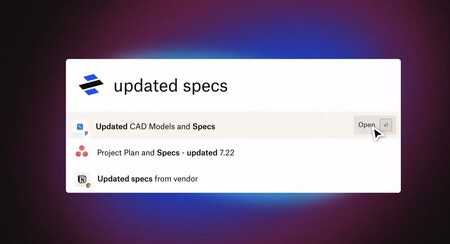Universal search is an old dream that many digital companies have tried to realize, but as our digital life has ceased to be just files and folders, it has become more difficult to offer it successfully. We no longer only have documents, images and so on in folder trees, but also open tabs, cloud-native documents like Google or Microsoft, content and messages on AirTable, Notion, Slack…
Dropbox, which has historically specialized in file and folder structures, wants to transcend this barrier and unify search across our entire digital life, whether we’re trying to locate a photo, video, Chrome tab, Teams message, or email. forgotten link in a Zoom chat.
Transcend traditional file systems
This story begins long before the internet was turned upside down by whatever coined the term “Artificial Intelligence”, which coincides with the arrival of ChatGPT. This story begins in October 2021, when Dropbox announced the purchase of Command E. In the same official statement made it clear what Command E was capable of and what we could expect to come to Dropbox:
Early on, the Command E team recognized that more cloud-based software meant work was spread across numerous tools and apps, making it harder to find important content quickly. Built on the premise of using keyboard shortcuts to find things fast, they built a powerful unified search tool that helps users quickly access everything they need, from locating content in apps to launching workflows. things like joining a Zoom call with a single click. As the productivity software ecosystem continues to grow, Command E provides a vital layer that brings it all together.
The result is called dasha tool that we can invoke in macOS from (you would never guess) the key combination Command + AND. Those who have tried the usual alternatives to Finder, like Alfred; or ubiquitous tools accessible at the stroke of a command, such as Raycast, will have someone familiar here.
The view that pops up when we invoke Dash, very similar to Spotlight on macOS. Image: Dropbox.

Expanded view of Dash. Image: Dropbox.
Promises enough intelligence to anticipate us based on context. For example, in addition to the aforementioned command, it also includes an extension for our browser that changes our new tab view. With it, we will be able to see what Dash understands that will be useful to us at this time. For example, the Dropbox documents associated with the meeting we have scheduled on the calendar for ten minutes from now.

The new tab view that appears when we have the Dash extension installed. Includes view of upcoming calendar events, contextual document suggestion based on upcoming events and time of day, and a summary of open tabs. Image: Dropbox.
Something interesting is that it not only includes the usual file classification in the classic file and folder system, but also delivered to stacks of files that share an extension or other type of attributeincluding contextual.
This connects with something that Javier Pastor, a colleague, commented a few months ago in his article “Folder? What is a folder? The new generations no longer organize their files: the search engine finds everything”. In it, he explained that young people, due to their arrival in the world of computing, are no longer as accustomed to this type of file system as previous generations.

The arrival of Dash is very much in line with that conception: it is no longer so important to worry about creating a file system that gives documents an order, because AI and searches will be able to locate and display the appropriate documents that we need based on of the moment.
This is a foundational change in file systems.. Dropbox has spent all these years bringing legacy rankings from local management to the cloud, and now it embraces universal search mixed with an AI-based contextual system. In other words: the management of your files, tabs and documents is provided by Dropbox, not by you.
Dash is part of Dropbox’s Pro plans, though it’s still in private beta with an invite-only waitlist. From xataka We do not order anyone to leave the management of their file systems in the hands of others, human to AIs, at least for what may happen, but each one will decide.
Featured Image | Xataka, Dropbox, Mockups Studio.
In Xataka | “Finally a paid member!”: WinRAR’s revealing reaction when a user checked out after a 40-day free trial.




![[Img #74674]](https://thelatestnews.world/wp-content/uploads/2024/12/Santiago-Ramon-y-Cajal-The-promoter-of-modern-neuroscience-150x150.jpg)








![[Img #74674]](https://thelatestnews.world/wp-content/uploads/2024/12/Santiago-Ramon-y-Cajal-The-promoter-of-modern-neuroscience-300x200.jpg)

